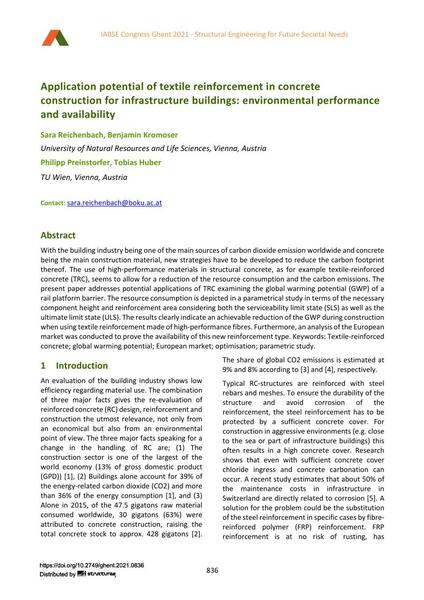Application potential of textile reinforcement in concrete construction for infrastructure buildings: environmental performance and availability

|
|
|||||||||||
Bibliografische Angaben
| Autor(en): |
Sara Reichenbach
Benjamin Kromoser Philipp Preinstorfer (TU Wien, Vienna, Austria) Tobias Huber (TU Wien, Vienna, Austria) |
||||
|---|---|---|---|---|---|
| Medium: | Tagungsbeitrag | ||||
| Sprache(n): | Englisch | ||||
| Tagung: | IABSE Congress: Structural Engineering for Future Societal Needs, Ghent, Belgium, 22-24 September 2021 | ||||
| Veröffentlicht in: | IABSE Congress Ghent 2021 | ||||
|
|||||
| Seite(n): | 836-844 | ||||
| Anzahl der Seiten (im PDF): | 9 | ||||
| DOI: | 10.2749/ghent.2021.0836 | ||||
| Abstrakt: |
With the building industry being one of the main sources of carbon dioxide emission worldwide and concrete being the main construction material, new strategies have to be developed to reduce the carbon footprint thereof. The use of high-performance materials in structural concrete, as for example textile-reinforced concrete (TRC), seems to allow for a reduction of the resource consumption and the carbon emissions. The present paper addresses potential applications of TRC examining the global warming potential (GWP) of a rail platform barrier. The resource consumption is depicted in a parametrical study in terms of the necessary component height and reinforcement area considering both the serviceability limit state (SLS) as well as the ultimate limit state (ULS). The results clearly indicate an achievable reduction of the GWP during construction when using textile reinforcement made of high-performance fibres. Furthermore, an analysis of the European market was conducted to prove the availability of this new reinforcement type. |
||||
| Stichwörter: |
Treibhauspotenzial Optimierung Textilbeton
|
||||
| Copyright: | © 2021 International Association for Bridge and Structural Engineering (IABSE) | ||||
| Lizenz: | Die Urheberrechte (Copyright) für dieses Werk sind rechtlich geschützt. Es darf nicht ohne die Zustimmung des Autors/der Autorin oder Rechteinhabers/-in weiter benutzt werden. |
||||
